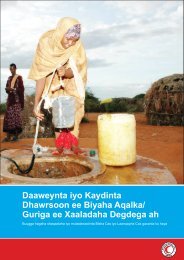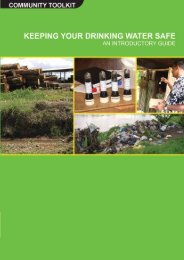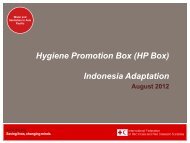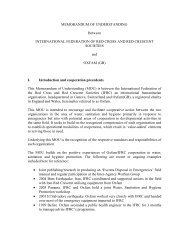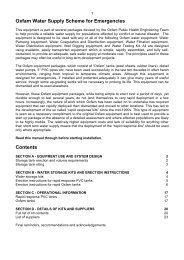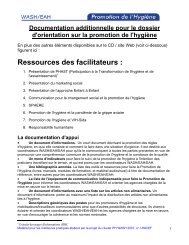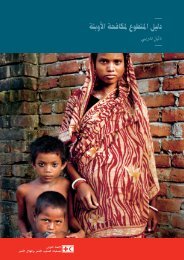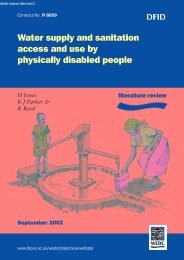Hygiene Promotion - IRC International Water and Sanitation Centre
Hygiene Promotion - IRC International Water and Sanitation Centre
Hygiene Promotion - IRC International Water and Sanitation Centre
You also want an ePaper? Increase the reach of your titles
YUMPU automatically turns print PDFs into web optimized ePapers that Google loves.
5.2 Case studies: AsiaIndia 1: A decade of hygiene education in KeralaTopics: Integrated projects; training; PHASTThe first integrated rural water supply <strong>and</strong> environmental sanitation project in Kerala, India,supported by DGIS <strong>and</strong> Danida, introduced a hygiene education component in both water<strong>and</strong> sanitation activities more than a decade ago. The first <strong>and</strong> foremost thing is to identify<strong>and</strong> train good cadres of committed social workers for community mobilisation <strong>and</strong>education (including hygiene). The main goal is that the workers should be able to selectthe right type of approach or combination of approaches for each situation <strong>and</strong> use themeffectively. They use very simple methodologies for communication. They avoidsophistication <strong>and</strong> high-profile jargon from the sector. This involves more than simplyexplaining the importance of hygiene education to the people. Adequate thrust has to begiven to studying <strong>and</strong> underst<strong>and</strong>ing how beliefs <strong>and</strong> attitudes influence behaviour(especially hygiene practices) <strong>and</strong> thus affect disease transmission. Based on the outcomeof the local assessment, the project designed a (one time) radio programme on hygieneeducation in water supply <strong>and</strong> environmental sanitation for a period of six months.Schools were used as focal points for popularising the water <strong>and</strong> sanitation programme.This includes the value of water, water management, h<strong>and</strong>ling of water, hazards of openairdefecation, use <strong>and</strong> maintenance of WATSAN facilities etc. The case study contributorwas involved in the PHAST methodology at the pre-testing stage. He commented that “itthen became an academic exercise, <strong>and</strong> it was quite disappointing that not much focuswas given to learning from others”. However, afterwards other participatory learningmethods for school sanitation <strong>and</strong> hygiene education were developed <strong>and</strong> are nowpublished in a forthcoming manual: The Joy of LearningEmail: bkurup@md3.vsnl.net.inFor details, see K. Balach<strong>and</strong>ra Kurup et al, The community managed sanitationprogramme in Kerala: Learning from experience, <strong>IRC</strong> Project <strong>and</strong> Programme Papers, 4-E,1996). http://www.irc.nl/page/1869The Joy of Learning is available at http://www.irc.nl/page/167Palestine : The <strong>Hygiene</strong> Improvement Framework in 45 villagesTopics: HIF; baseline study; impact analysisThe EHP <strong>and</strong> Save the Children have implemented the USAID-funded Village <strong>Water</strong>Systems (VWS) Project in 45 villages in the West Bank in West Hebron <strong>and</strong> South Nablus.Villages range in size, but most are under 5,000 in population. VWS consists of threeprimary components, all of which track very closely with the <strong>Hygiene</strong> ImprovementFramework. The largest component is the engineering design (access to hardware) of thewater supply systems. All the water supply systems are piped. The second component isthe establishment of three joint services councils (enabling environment). Joint services42 <strong>Hygiene</strong> promotion



